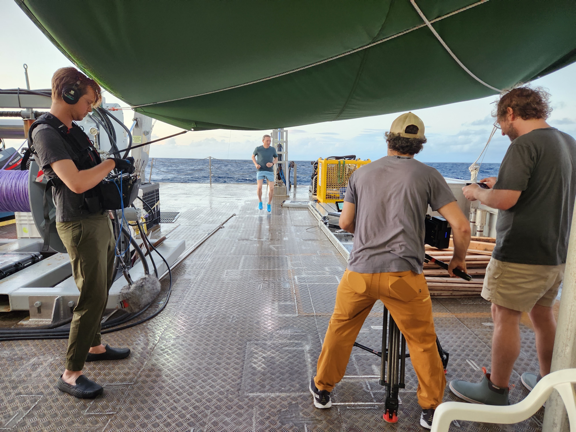Diary of an Interstellar Voyage, Report 37
(July 11, 2023)

Over the past week, the spherules of the first recognized interstellar meteor, IM1, were delivered in two packages to the doorstep of my home by FedEx. Before this delivery, they landed on the Pacific Ocean floor nearly a decade ago after a journey that likely lasted billions of years in interstellar space.
Radioactive isotopes like Uranium 235 & 238 which decay into Lead 207 & 206, can be used as clocks that record the age of the spherules. If the radioactive dating that we will conduct in the coming weeks would imply that IM1’s spherules are definitely older than solar system material, then we would have an independent confirmation of the letter from the US Space Command to NASA about the interstellar origin of IM1.
In a strange way, blue-sky scientific analysis of this type would validate the quality of the sensors that the US government used to measure the speed of IM1. This confirmation is no trivial matter, as it has implications for national security — given that the same sensors are used to search for ballistic missiles. That it is also not a trivial scientific conclusion was highlighted by a paper last week in The Astrophysical Journal which dismissed the quality of the government’s measurement and the content of the government’s official letter about IM1. Altogether, the spherules that I was holding in my hands after the FedEx delivery carried historic significance because this is the first time that humans recovered materials from a meter-scale object that originated outside the solar system.
Most people do not know that the discovery of IM1 was a complete coincidence as a result of a radio interview that I had, exactly five years after IM1’s discovery date in January 2014.
Following my work on the interstellar object, `Oumuamua, detected almost 4 years after IM1 — on October 19, 2017, I came up with the idea to search for an interstellar meteor in the CNEOS catalog of meteor fireballs compiled by NASA’s Jet Propulsion Laboratory. This resulted from a radio interview that I had with John Catsimatidis at the beginning of January 2019, where I was asked to comment on a 10-meter-sized meteor that exploded over the Bering Sea a few weeks earlier on December 18, 2018. While searching the online literature on meteors, I came across the CNEOS catalog which included velocity data from US government sensors, and asked my undergraduate student at that time, Amir Siraj, to check whether the fastest meteors in the catalog might be of interstellar origin. Amir checked and reported back that the CNEOS meteor detected on January 8, 2014, would be an excellent candidate for what I asked him to find, namely an object with a speed relative to the Sun that exceeds the escape speed at Earth’s location, 42.1 kilometers per second.
IM1 collided with Earth with a speed of 45 kilometers per second, but arrived from behind to Earth’s orbit around the Sun. If Earth had the opposite direction of motion around the Sun, then IM1’s speed relative to Earth would have been about 90 kilometers per second. We realized that in the local frame of the Milky Way galaxy, the so-called local standard of rest, IM1 was moving at 60 kilometers per second, faster than 95% of all stars in the vicinity of the Sun.
Based on the air ram-pressure that IM1 sustained before disintegrating in three flares 20 kilometers above the ocean surface, we concluded that IM1 was tougher in material strength than all other 272 meteors in the CNEOS catalog. The New Horizons spacecraft is now heading towards interstellar space and could appear as a meteor of unusual material strength and anomalous speed were it to collide with an exoplanet in the future.
The research team that I lead as the expedition’s chief scientist is now engaged in writing a comprehensive scientific paper, detailing the results from the finding of IM1’s spherules. These sub-millimeter marbles were found primarily along the likely path of IM1, and not in distant control regions which represent the background from other sources. Moreover, preliminary analysis of two spherules from IM1’s path indicates that their age is likely higher than that of the solar system.
I assigned the analysis of the spherules to independent teams of experts in three laboratories: one at Harvard, the second at UC Berkeley and the third at the Bruker Corporation in Germany. Their state-of-the-art instruments include mass spectrometers, electron microscopes and X-ray fluorescence analyzers of exceptional quality.
When I sent some materials by FedEx to Germany, I had to declare the content of the package. I defined it as “sand” and assigned “zero commercial value” to it. Obviously, the samples have enormous scientific value.
The first scientific question we would address is whether the abundances of radioactive isotopes and rare elements distinguish IM1’s spherules from solar system materials. As a follow-up, we will be interested to know whether there is any hint of a technological origin. Consider, for example, the rare elements that may be found in molten droplets from computer screens or semiconductors that were exposed to the immense heat from IM1’s fireball, which released a few percent of the Hiroshima atomic energy into 500 kilograms of matter.
I purposely assigned the analysis task to experts who have the very best diagnostic tools in the world and possess no bias in their professional expertise. We will accept any readings that their instruments provide and report the results in our forthcoming paper.
The expedition is a teaching moment in two important ways. First, it demonstrates that science can be exciting by resonating with the public’s interest. Second, it suggests that the work of science should not be diminished by the superficial undertones of social media or academic jealousy. A week before I left for the expedition, I was told by colleagues that we would not find anything and a week after I returned I was told that we did not find anything. The only assurance I have are the spherules that I can hold in my hand and send for analysis by the best instruments that the scientific world has to offer.
During my routine jog at sunrise on the deck of Silver Star, I realized that I am not only running away from some colleagues who are not seeking evidence before expressing opinions, but I am also running towards a higher intelligence in interstellar space.


ABOUT THE AUTHOR

Avi Loeb is the head of the Galileo Project, founding director of Harvard University’s — Black Hole Initiative, director of the Institute for Theory and Computation at the Harvard-Smithsonian Center for Astrophysics, and the former chair of the astronomy department at Harvard University (2011–2020). He chairs the advisory board for the Breakthrough Starshot project, and is a former member of the President’s Council of Advisors on Science and Technology and a former chair of the Board on Physics and Astronomy of the National Academies. He is the bestselling author of “Extraterrestrial: The First Sign of Intelligent Life Beyond Earth” and a co-author of the textbook “Life in the Cosmos”, both published in 2021. His new book, titled “Interstellar”, is scheduled for publication in August 2023.
